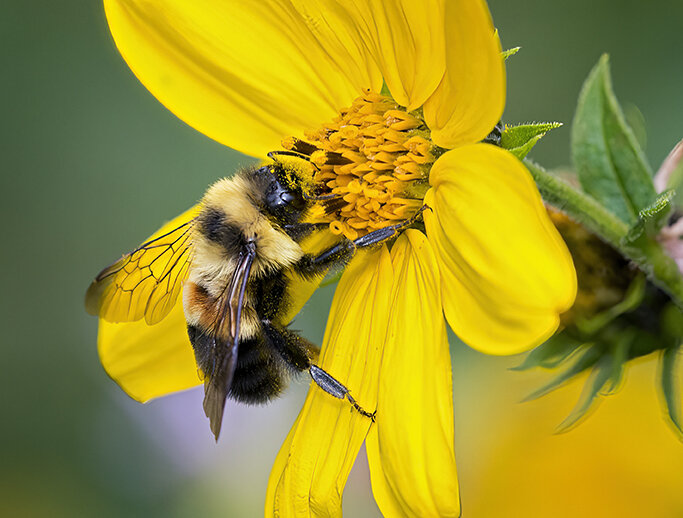A comprehensive and highly detailed map of the genome of the rusty patched bumble bee, an endangered species, has been released by scientists from the U.S. Department of Agriculture (USDA) Agricultural Research Service (ARS) and U.S. Fish and Wildlife Service (USFWS). This breakthrough offers new possibilities for conserving and reviving the native pollinator from the brink of extinction.
The creation of the rusty patched bumble bee genome is part of the innovative Beenome 100 project. Through this project, experts aim to build a library of top-quality, highly intricate genome maps for 100 or more distinct bee species found in the United States. The Beenome 100 project is a collaborative effort between ARS and the University of Illinois.
It is expected that this library of genomes will enable researchers to address major questions concerning bees, such as identifying the genetic differences that make certain species more vulnerable to climate change or more susceptible to pesticides.
The rusty patched bumble bee (Bombus affinis) plays a critical role as a pollinator for bergamot, milkweed, and various other wildflowers, as well as for crops like cranberries, plums, apples, and alfalfa. However, over the past two decades, their population has declined by a staggering 87%.
In 2017, this species was officially classified as “endangered.” Previously widespread across 28 states in the Upper Midwest and Northeast, as well as in 2 Canadian provinces, the rusty patched bumble bee is now restricted to isolated areas in just 13 states and one Canadian province. One of the few places where they are still regularly seen is the Minneapolis-St. Paul area of Minnesota and Wisconsin.
Research entomologist Jonathan B. Uhaud Koch, who works at the ARS Pollinating Insect-Biology, Management, Systematics Research Unit in Logan, Utah, emphasized the significance of the detailed information gathered from the newly sequenced genome. This information opens up exciting possibilities for developing innovative strategies to bolster rusty patched bumble bee populations.
Koch pointed out that some factors contributing to the decline of rusty patched bumble bees, such as loss of habitat, reduced variety of nectar sources, climate change, exposure to pesticides, and increased pathogens and pests, are already known. However, the presence of the fungal pathogen Varimorpha bombi, which has a detrimental impact on many rusty patched bumble bee populations, was detected in larger quantities than expected in the genome map.
Only state-of-the-art technology allowed the researchers to sequence an entire genome, composed of 15,252 genes and 18 chromosomes, using a small piece of abdominal tissue from a single male bumble bee. The researchers obtained around 4.5 percent of the DNA from Microsporidia, the fungal group that includes Varimorpha bombi. This highlights the pervasive nature of the pathogen in these bees.
Koch explained that the high-quality genome will facilitate the identification of genetic differences between populations of rusty patched bumble bees that are thriving versus those in decline. This knowledge may lead to a better understanding of the genes that provide certain populations with adaptability and resilience to their environment. Furthermore, it can shed light on the genetic factors influencing bumble bee behavior, physiology, and ability to adapt to changing environmental conditions.
Once the genes that contribute to the success of specific local conditions are identified, researchers can use this information to enhance and restore rusty patched bumble bee populations in targeted areas through captive breeding programs.
The research findings were published in the journal G3: Genes | Genomes | Genetics, and the genome can be accessed on the National Center for Biotechnology Information website https://www.ncbi.nlm.nih.gov/assembly/GCF_024516045.1/.
More information:
Jonathan Koch, Chromosome-scale genome assembly of the rusty patched bumble bee, Bombus affinis (Cresson) (Hymenoptera: Apidae), an endangered North American pollinator, G3: Genes | Genomes | Genetics (2023). DOI: 10.1093/g3journal/jkad119
Citation:
Completing the rusty patched bumble bee genome may offer new approach to saving endangered bee (2023, June 19)
retrieved 19 June 2023
from https://phys.org/news/2023-06-rusty-patched-bumble-bee-genome.html
This document is subject to copyright. Apart from any fair dealing for the purpose of private study or research, no
part may be reproduced without the written permission. The content is provided for information purposes only.
Denial of responsibility! SamacharCentrl is an automatic aggregator of Global media. In each content, the hyperlink to the primary source is specified. All trademarks belong to their rightful owners, and all materials to their authors. For any complaint, please reach us at – [email protected]. We will take necessary action within 24 hours.

Shambhu Kumar is a science communicator, making complex scientific topics accessible to all. His articles explore breakthroughs in various scientific disciplines, from space exploration to cutting-edge research.


